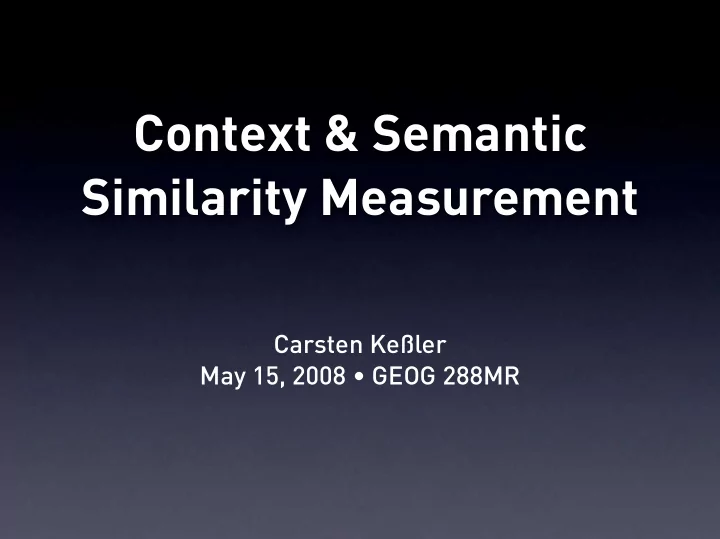

Context & Semantic Similarity Measurement Carsten Keßler May 15, 2008 • GEOG 288MR
ToDo • Discuss the papers: • Dey & Abowd (2000) Towards a Better Understanding of Context and Context-Awareness • Rodríguez and Egenhofer (2004) Comparing geospatial entity classes: an asymmetric and context-dependent similarity measure • Keßler (2007) Similarity Measurement in Context • Discuss my ideas
Motivation
More Motivation
More Motivation Even
So: What is Context? • Dey & Abowd (2000) Towards a Better Understanding of Context and Context- Awareness • Motivation: make the vague notion of context more concrete
UbiComp Definition „Context is any information that can be used to characterize the situation of an entity. An entity is a person, place, or object that is considered relevant to the interaction between a user and an application, including the user and applications themselves.“
Context Categories • Location e.g. Europe, NY, Del Playa, Room 53, Shelf 12b • Identity e.g. users & people/devices (!) they interact with • Activity e.g. meeting, shopping, sleeping • Time e.g. spring, May 15, playoff season, 1210874400
Context Awareness „A system is context-aware if it uses context to provide relevant information and/or services to the user, where relevancy depends on the user’s task.“
Categorization of Context Aware Features • Information presentation • Service execution • Information tagging
Similarity and Context in GIScience • Rodríguez and Egenhofer (2004) Comparing geospatial entity classes: an asymmetric and context-dependent similarity measure
Remember MDSM?
Knowledge Representation • MDSM comes with its own specific knowledge representation • Using Backus Naur Form for entity class definitions • Ontology for the paper created from WordNet and SDTS
Context in MDSM • Domain of application – the set of entity classes that are subjects of the user‘s interest • Selection based on user activities, i.e., operations associated with a set of entity classes
Examples
Diagnosticity / Feature Relevance • How significant is a specific feature to distinguish a specific entity class from the other classes in the set under consideration? • Variability vs Commonality
Variability • Stress distinguishing features based on • number of occurrences o i • number of entity classes n • number of features l
Commonality • Counterpart to the variability measure • Stress common features • How much does a specific feature contribute to the characterization of a domain of application?
MSDM & Context in Practice Intensional context
MSDM & Context in Practice Extensional context
HST Results • Commonality approach works better for intensional context specifications • Variability approach works better for extensional context specifications
A More Generic View • Me (2007) Similarity Measurement in Context • Motivation: Find out about the influence of context on similarity measurements – independent of similarity theory
„How similar is a to b?“ b ? a knowledge base a CONTEXT b explicit automatic context context input capturing „injection“ of additional context (extend the a output of knowledge base) similarity value b weighting a a similarity measurement selection of b b domain of application
My Context Definition „A similarity measurement‘s context is any information that helps to specify the similarity of two entities more precisely concerning the current situation . This information must be represented in the same way as the knowledge base under consideration, and it must be capturable at maintainable cost .“
False Assumptions… „The more similar two contexts are, the less a similarity measurement should change between those two contexts“
Some Recent Ideas • Context rules: concepts may change in a specific context
Formally e.g.,
Concept- vs. Instance Affecting Context knowledge base STEP A : similarity measurement A Calculate similarity ranking for concepts B c u c d c r c i C providing concepts for QUERY CONTEXT instance annotation c u c r instance database STEP B : Instance # Type Name ... Identify matching 1 A ... ... instance selection instances 2 B ... ... 3 C ... ... 4 A ... ... ... ... ... ...
Context Impact Measure CIM: a method to quantify the shifts in the results caused by a change in context Canal River Canal Stream Channel Ocean Sea Stream Aqueduct Aqueduct IrrigationCanal Reservoir IrrigationCanal Reservoir Spring
Depends on Result Visualization 1. River 1. River 2. Canal 2. Canal, Lake 3. Aqueduct 3. Aqueduct, IrrigationCanal 4. Lake, Sea, Spring 4. Spring 5. IrrigationCanal 5. Reservoir
CIM Characteristics • Works solely on result sets • Independent of knowledge representation • Returns values from 0 to 1 • Focus on the top results via weights • Should be cognitively plausible • HPT is in the pipeline
Result Visualization
Coffee, anyone?
Recommend
More recommend